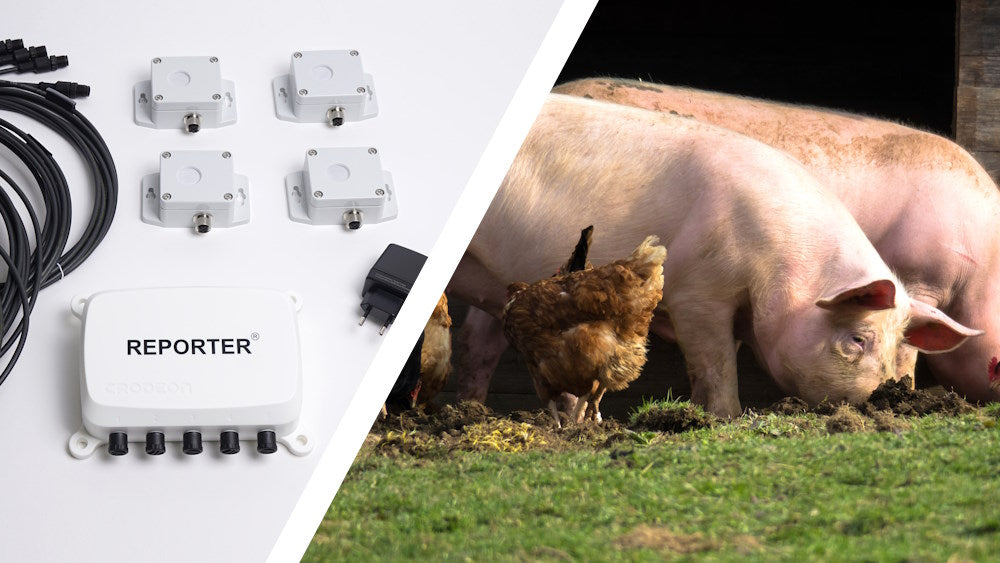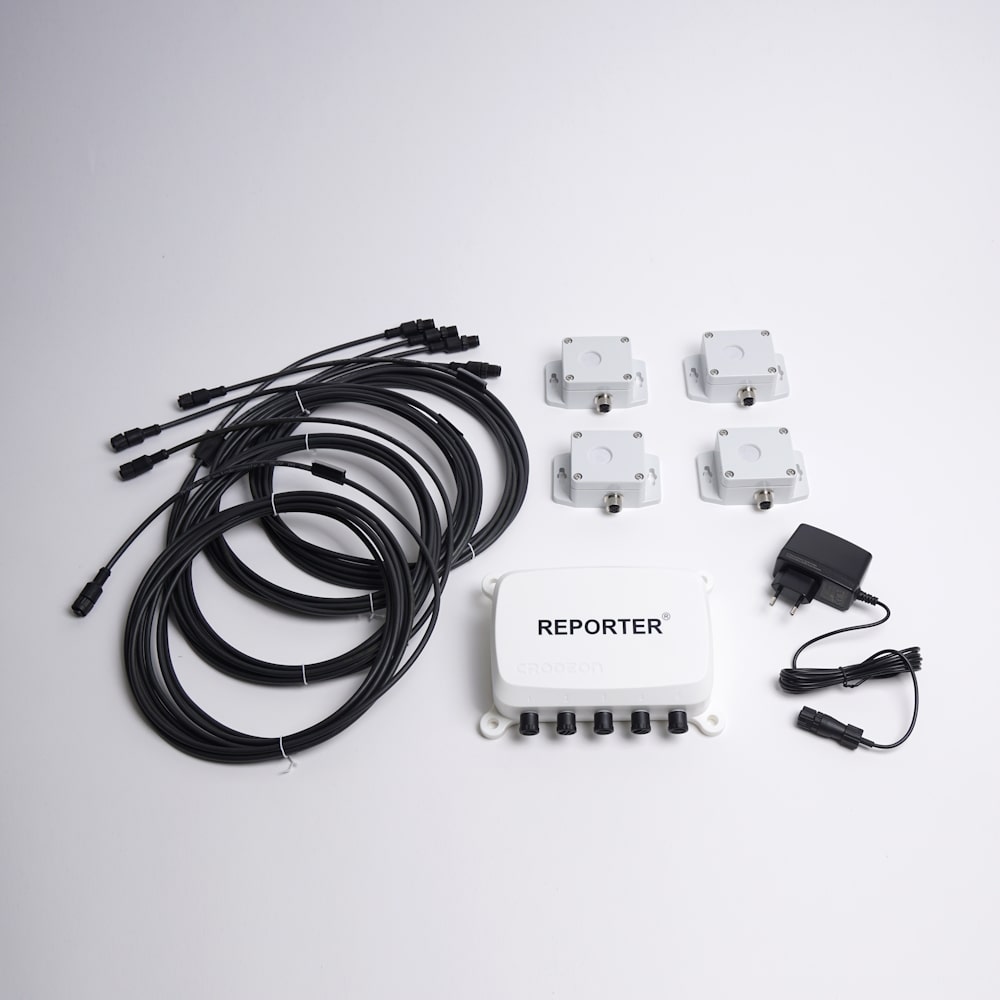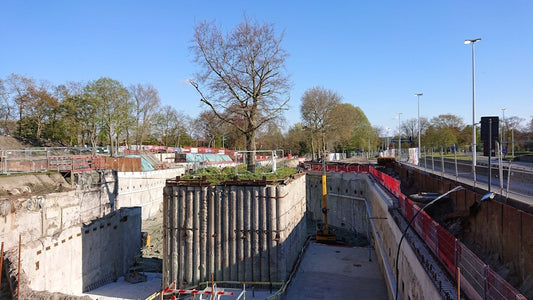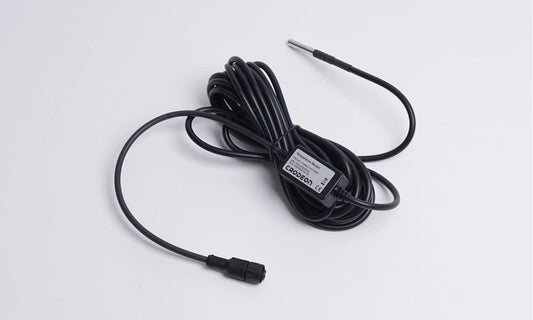CO2 monitoring in livestock: long overdue

Maintaining a healthy environment is essential in livestock farming, yet one critical factor is often overlooked: carbon dioxide levels. While temperature monitoring systems have been standard for years, CO2 levels frequently go unmonitored. In KU Leuven's 2024 MA thesis by Bregtje Jacobs, our suspicions get confirmed: CO2 monitoring in livestock is long, long overdue.
KBC, Boerenbond, and KU Leuven
For this master's thesis, several leading companies teamed up to find out what part of the puzzle was still missing in livestock farming.
- KBC is a Belgian bank and insurance company that also specialises in agricultural insurance.
- Boerenbond (lit. Farmers' union/association), is the Flemish farmer's union promoting the interests of agriculturalists.
- KU Leuven (lit. Catholic University of Leuven) is a Belgian university that has historically been associated with agricultural research.
Crodeon also joined; we provided Reporter and sensors, the measuring equipment.
The purpose of the research
“This study aims to make readers aware of the shortcomings of current climate control and monitoring systems. The trial tested a monitoring and alarm system [Reporter] that operates independently of the existing climate control system.” - Jacobs, 2024
The research explains that existing alarm systems tend to focus solely on temperature monitoring in livestock. The parameter CO2 is often overlooked, even though it is equally (if not more) important.
Longtime exposure to carbon dioxide concentrations exceeding 3000 ppm (parts per million), result in unhealthy livestock. This often translates to sickly, meagre animals that the farmer can't sell for the intended profit. Chickens exposed to 12000 ppm weighed 8% less at four weeks of age compared to their peers who were raised in a healthy CO2 range.
7 Months of research
To collect data, Reporter was installed in nine Belgian farms, three poultry farms and six pig farms. The measuring and monitoring system was equipped with four Crodeon multi-parameter CO2 sensors (temperature, relative humidity, carbon dioxide).
From the 17th of July 2023 to the 8th of March 2024, the farms were monitored. Data was collected and streamed to the Crodeon Dashboard (cloud platform). Through the Dashboard, Reporter could be configured to send out alarm notifications once a set level of a parameter had been exceeded. For livestock, the most important parameters are carbon dioxide and temperature.
Exceeded CO2 limits, without exception
The legal CO2 limit in livestock farming is set at 3000 ppm, measured at the breathing height of the animals. For reference, fresh outside air contains about 400 ppm CO2. Carbon dioxide is also heavier than oxygen, causing it to sink and collect close to the ground rather than float up. When the air at the animals' breathing height contains too much carbon dioxide and other harmful gases and lacks sufficient oxygen, suffocation is inevitable.

Figure 1 ‘Varkens’ lit. ‘Pigs’ shows the CO2 range that was measured at the six different pig farms during this experiment. The red line represents the 3000 ppm limit. As we can see, all farms exceeded this limit at some point during the experiment, with one peak even exceeding 9000 ppm, triple the legal limit.

Figure 2 ‘Pluimvee’ lit. ‘Poultry’ shows the CO2 range that was measured at the three different poultry farms during this experiment. The red line represents the 3000 ppm limit. As we can see, again all farms exceeded this limit at some point during the experiment, with one peak nearing 9000 ppm, almost triple the legal limit.
Not only does a high concentration of carbon dioxide come with suffocation risks resulting in death, but it also causes a decline in the quality of the meat and behavioural changes in the livestock (such as cannibalism and other forms of aggression).
Minimised ventilation during colder weather
All farms scored badly regarding CO2 management during colder outdoor temperatures. As the outdoor temperatures became colder than 10-15°C and 0-5°C in poultry and pig farms respectively, carbon dioxide concentrations exceeded the legal limit of 3000 ppm. The reason? Ventilation was minimised to preserve heat inside the barns.
Another reason was to keep very young chicks warm during their first weeks. For this purpose, farmers often use fuel-powered heat guns (heat cannons) to generate heat. These forms of heat generation combine the rapid burning of fossil fuel with a powerful fan. These forms of open fire, also directly result in higher CO2 concentrations inside farms.
Ventilation failures
During the experiment, ventilation failures occurred at three separate times. This resulted in interesting data showcasing the real danger of a faulty ventilation system in pig and poultry barns. In all cases, the temperature-based alarming system had not yet registered the ventilation failures.
| Date | Duration in minutes | Total temperature increase in °C | Total CO2 increase in ppm |
| August 31st 2023 (figure 3) | 36 | 3.8 | 5945 |
| September 10th 2023 | 22 | 1.7 | 3146 |
| September 11th 2023 | 21 | 2 | 2589 |
Within 30 minutes, the CO2 concentrations in the barn grew from 2000 ppm to nearly 9000 ppm. The indoor temperature on the other hand, barely grew within this same time frame. At the time the temperature would have exceeded the set alarm limits of a traditional system, the animals would likely already have succumbed due to a lack of oxygen.
“At high concentrations, animals experience dizziness and unconsciousness, while at very high concentrations (30,000 ppm), it can cause death by asphyxiation.” - Buoio et al., 2023
When we compare the data of all three cases, we can conclude that per increase of 1000 ppm, the temperature only increased by 0.54-0.77°C. Extrapolating this to an increase of 28,000 ppm (on top of the usual base value of 2000 ppm CO2), it would take only a rise of 15-22°C until the lethal level of 30,000 ppm is reached.

Figure 3, ventilation August 31st, 2023.
Conclusion
Carbon dioxide monitoring in livestock farms is long overdue. During ventilation failures, temperatures rise significantly slower than CO2 concentrations do. Traditional monitoring systems that solely use temperature as an alarming parameter, react slower than an alarm system that (also) measures CO2 levels in ppm. By the time a traditional temperature-based alarm system sends out alarm notifications, the animals have already been exposed to high levels of CO2 for an extended period.
Extremely high carbon dioxide levels (30,000 ppm) are lethal. High levels are detrimental to the overall health of the livestock and result in less body weight at slaughter age as well as a less qualitative product.
Reporter is a plug and play monitoring module, that is compatible with CO2 sensors to measure and monitor CO2 in a livestock barn. The monitoring module can be configured through the Crodeon Dashboard to send out alarm notifications once a set level for a parameter (such as carbon dioxide) has been exceeded.
Contact us
Are you looking for a user-friendly way to start your own pig CO2 monitoring project or install your own poultry monitoring system? Don’t hesitate to reach out!
Sources
- Jacobs, B. (2024). Preventie van hittestress en verstikking bij vleeskippen en vleesvarkens [MA Thesis]. KU Leuven.
- Buoio, E., Cialini, C., & Costa, A. (2023). Air quality assessment in pig farming: The Italian Classyfarm. Animals, 13(14), 2297. https://doi.org/10.3390/ani13142297










